| BrianRxm | The 1949 San Francisco Mexico Peso Restrikes | BrianRxm |
| Coins struck by the San Francisco and Mexico City Mints |
For the Nationalist Republic of China
During the summer of 1949 the San Francisco and Mexico City Mints struck 10,250,000 copies of the
1898 Mexico peso for the China Nationalist government to pay soldiers fighting the Communists.
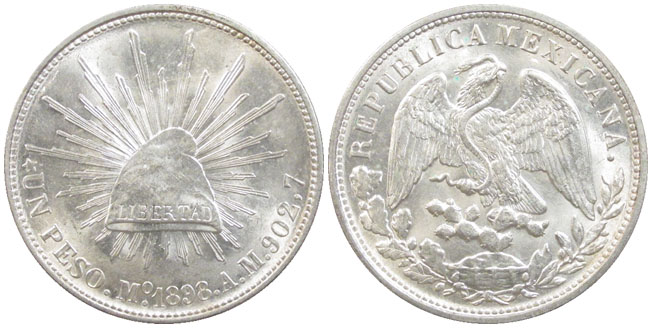
1. Mexico 1898 peso (1949 restrike)
Silver, 39 mm, 27.03 gm
Obverse: "Liberty Cap" and rays
Reverse: Eagle on cactus holding serpent in beak
Reverse: Eagle on cactus holding serpent in beak
Introduction:
In 1949 the American Numismatic Association (ANA) held it's annual convention in San Francisco from
August 21 to 24, 1949.
During the convention some members were given tours of the San Francisco Mint where they watched
coins being struck, including silver dollars.
The attendees, mostly being numismatists knowledgeable about United States coins, knew that the
United States wasn't making silver dollars then. Some recognized the design on the coins of an
eagle sitting on cactus holding a snake as the national emblem of Mexico.
Dr. Alberto Francisco Pradeau, a Mexican numismatist, was on one of the tours and when he returned
to Mexico he researched the pesos and the reasons for them being struck.
Mexican silver pesos in China:
For centuries the mints of Spain and later independent Mexico produced the silver dollar-size
eight reales and peso coins which circulated all over the world, especially in China.
A real (plural: reales) was originally a Spanish denomination and eight reales made a peso.
The pesos circulated in the American colonies before the American Revolution where they were
known as "Spanish milled dollars." After the revolution they formed the basis for the United States dollar.
The eight reales coins were the "pieces of eight" beloved by pirates.
The Chinese people and merchants were familiar with Mexican peso coins as they were used
extensively in China as "trade dollars" in the 19th and early 20th centuries.
People would sometimes refer to them as "Mex dollars."
China 1934 dollar coin:
In 1934 the China Shanghai mint manufactured almost 100,000,000 silver dollars with Sun Yat-Sen,
the founder of the Republic of China in 1912, on them. The master dies for these coins were made
at the United States Philadelphia Mint.

2. China 1934 Sun Yat-Sen silver "boat" dollar
Silver, 39 mm, 26.75 gm
China in 1949:
Since the end of World War II in 1945, China had undergone a civil war between the
Nationalist or Kuomintang government of General Chiang Kai-Shek and the Communist revolutionary army
of Chairman Mao Tse-Tung. By early 1949, the Communists controlled most of the country.
The Nationalist paper currency had become massively inflated with a United States dollar being worth
millions of Chinese Nationalist paper yuan or dollars.
In 1949 the Nationalist government introduced a new silver-based "silver yuan" or "silver dollar"
currency to replace the inflated "gold yuan" currency which had replaced (in 1948) the inflated "fapi"
or paper dollar. This marked the return to the silver standard which China had abandoned in 1935.
Nationalist China also issued a new paper currency to be supported by the silver.
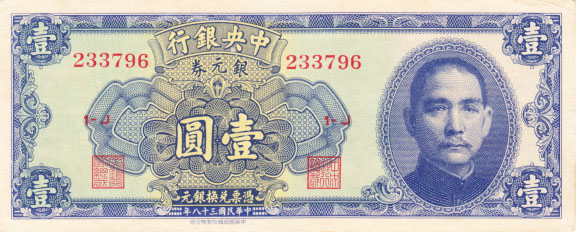
3. China silver dollar note 1949 front
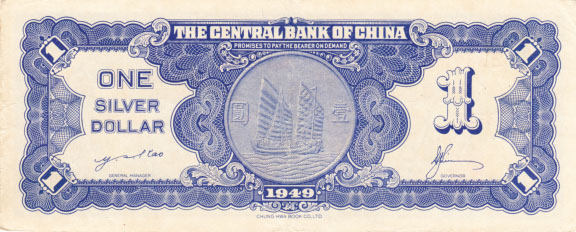
4. China silver dollar note 1949 back
The note depicts the reverse of a silver "boat" dollar.
As before, the paper money soon became inflated and then almost worthless.
By the summer of 1949, the Communists had overrun most of China and the Nationalist government
had been reduced to enclaves in Canton and Chungking.
Canton, formerly Kwangtung, now Guangzhou, is located on the Chinese coast near Hong Kong.
Chungking, now Chongqing, is located in central China and was the Nationalist capital of China.
The money situation became so bad that Nationalist servicemen refused to continue fighting unless
paid in silver. When paid in silver, the soldiers would receive one or two silver dollars per month.
Silver coins were needed quickly and there was not time to make new designs.
The United States was involved because it was supporting Chiang Kai-Shek's Nationalists to avoid
"losing" China to the Communists.
In June and July 1949 the three United States mints (Philadelphia, Denver, and San Francisco)
struck 30,000,000 copies of the 1934 Sun Yat-Sen silver dollar, first to support the new Silver Yuan
currency and later for general use.
The United States mints used dies made from the original 1934 master dies and there is no way
to tell the 1949 Sun Yat-Sen dollar restrikes from the 1934 originals. These dollars were shipped to
Canton via Hong Kong.
However more coins were needed, and the United States, Mexico, and China worked out a deal to
strike 10,250,000 Mexican peso coins to ship to China.
The Mexico 1949 Restrike:
It was decided to restrike an 1898 Mexico silver peso of the type listed in Krause's
Standard Catalog of World Coins as number KM 409.2
The Mexican peso was slightly larger than the United States silver dollar and has about 1.5% more silver.
Coin |
Size |
Weight |
Fineness |
ASW (Actual silver weight) |
Mexico peso |
39 mm |
27.07 gm |
0.9027 |
0.7859 |
Morgan dollar |
38 mm |
26.73 gm |
0.900 |
0.7734 |
China dollar |
39 mm |
26.70 gm |
0.880 |
0.7555 |
The Mexico City Mint was to strike 10,250,000 pesos but due to the urgency of the need,
the San Francisco Mint was subcontracted to strike 2,000,000 pesos leaving Mexico to strike
the remaining 8,250,000.
All of the dies for striking the pesos were prepared in Mexico City and small changes were made
to differentiate the restrikes from the 1898 originals.
The easiest way to tell a restrike from an original is to examine the coin's mintmark "Mo",
the mintmark of the Mexico City Mint for 400 years.
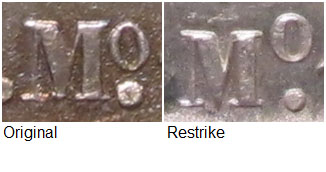
5. Mexico peso mintmarks, original and restrike
On the original peso the tops of the mintmark 'M' and 'o' lined up horizontally while on the restrike
the top of the 'o' is significantly higher than the top of the 'M'.
Supposedly one could tell the restrikes from the originals by the number of denticles, the beads
around the rim of the design, but as the denticle counts on original pesos differ from coin to coin
this method does not always work.
Original pesos have been observed with obverse denticle counts of 134, 139, and 140, and reverse
denticle counts of 137, 138, or 139.
The restrikes are more consistent with 134 denticles on the obverse and 131 on the reverse.
Coin distribution:
The Mexico City Mint and San Francisco Mint pesos had different fates.
The Mexico City Mint pesos were either shipped to China, stored at the mint, or sent to various
places in Mexico.
Dr. Pradeau found that of the 8,250,000 pesos produced by the Mexico City Mint between August to
November 1949, 2,526,978 were delivered to the Republic of China via Hong Kong and Canton,
1,942,000 were stored in the vaults of the Mexico City Mint, 3,779,000 were sent to Hermosillo, Sonora
during the month of June 1950 for melting, and 2,022 were kept by the Bank of Mexico.
Ironically, the Mexican Monetary Law of 1905 permitted restriking of the 1897 and previous
eight reales coins for export only, but not the 1898 and later peso coins.
Some of the restrike pesos were sold to the public as bullion coins as this was a normal practice in
Mexico which had struck it's own bullion "onza" coins in 1949.
These pesos also entered the world market after Chiang's people fled to Taiwan, taking with them an
enormous amount of gold and silver, no doubt including some of the recently arrived Mexican pesos.
The San Francisco Mint 2,000,000 pesos had a different fate.
They were struck at the mint from June to August of 1949 and were taken from the mint to the vaults
of the nearby Bank of America to await shipment to China. 2,000,000 silver dollars weigh around
sixty tons and one can imagine the storage charges imposed by the bank.
China fell to the Communists and the pesos were no longer needed, and to avoid paying more
storage charges, the coins were sold back to the San Francisco Mint, melted, and recycled into
American coins.
No San Francisco pesos were saved as few people learned of the striking before they were melted.
The price of silver increased during that period from $0.50 to $0.75 per ounce giving someone a profit.
Examples of original 1898 Mexico pesos:
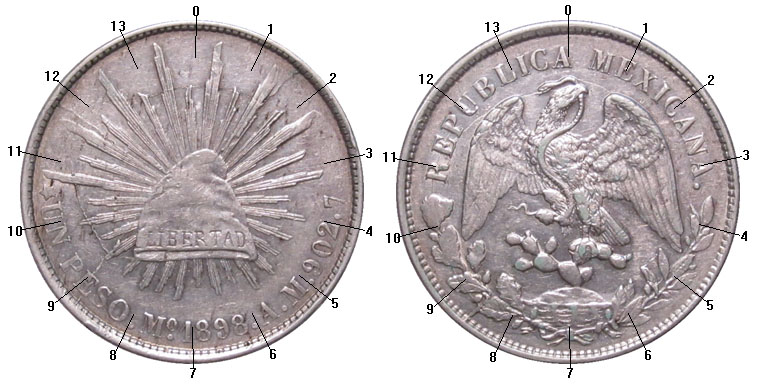
6. Mexico peso 1898 original number 1
Silver, 38 mm, 27.05 gm
The obverse has 140 beads and reverse has 139 beads.
This coin has a die crack on the obverse.
This coin has a die crack on the obverse.

7. Mexico peso 1898 original number 2
Silver, 38 mm, 26.96 gm
The obverse has 134 beads and reverse has 137 beads.
Example of 1949 restrike Mexico peso:
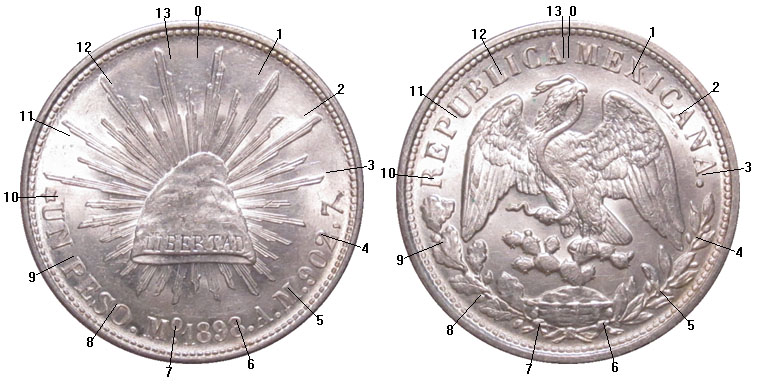
8. Mexico peso 1949 restrike
Silver, 38 mm, 27.06 gm
The obverse has 134 beads and reverse has 131 beads.
Current status of these coins:
The original and restrike pesos are not rare and can be found at coin dealers, coin shows, and on
internet sale and auction sites.
The original pesos are usually found in circulated condition and the restrikes are usually uncirculated.
Some sellers know and indicate a coin's original/restrike status but others do not.
All of the existing restrikes are from the Mexico City Mint as the San Francisco coins were never
released and were subsequently melted.
Circulated original coins are worth $25 to $50 and uncirculated ones $50 to $100.
Restrikes have similar prices.
Most of these coins are not third-party graded or "slabbed" but there are restrike coins
which the Professional Coin Grading Service (PCGS) has graded as uncirculated MS-62 and above.
Original pesos can sometimes have Chinese "chop marks" or stamped marks applied by merchants,
but the restrikes should not have them as this practice had ended in China by the 1920's.
Articles:
These unusual coins have been mentioned in some numismatic articles.
One article called the restrike peso coin "America's last trade dollar", but these coins have little to do with
the trade dollars of the late 1800's.
Some articles repeat the error that some San Francisco coins have survived, and that there are
design differences between San Francisco restrikes and Mexico City restrikes, this is impossible
as all of the dies were made at Mexico City.
And a final note:
Modern Chinese copies of these coins are available:
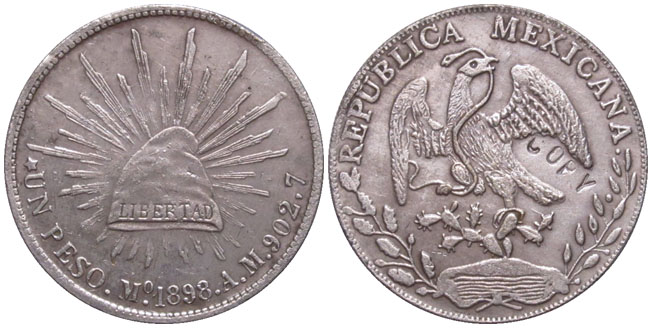
9. Chinese copy of Mexico restrike, marked "COPY"
Imitation silver, 38 mm, 18.84 gm
References:
Dr. Alberto Francisco Pradeau, "The San Francisco, California, Mexican Pesos of 1898",
for the Azteca Numismatic Society's newsletter Plus Ultra, September 27, 1968
Chester Krause, Clifford Mishler, Colin R. Bruce II, Standard Catalog of World Coins,
published by Krause Publications, Inc. yearly, usually referred to as "Krause",
The coin is listed in the 1995 edition as number KM 409.2,
Kenneth Bresset, R. S. Yeoman, A Guide Book of United States Coins or "Red Book", 57th Edition,
Whitman Publishing Company, 2004
Department of the Treasury, Bureau of the Mint, Domestic and Foreign Coins Manufactured by Mints of the
United States 1793-1980, US Government Printing Office, 1981
This publication has mintage numbers but little else about these coins.
Charles G. Altz and E. H. Barton, Foreign Coins struck at United States Mints
Whitman Publishing Company, 1965
This book states that only the United States restrikes have 131 beads on the reverse and the
originals have 139 beads.
Edward Kann, The Illustrated Catalog of Chinese Coins, Published by the author, 1953